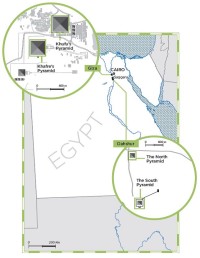Tag archives: Mexico
HAWC spots TeV gamma ray flare

Now you see it, now you don’t: a TeV gamma-ray flare spotted by HAWC. (Courtesy: Michelle Hui)
By Hamish Johnston at the APS April Meeting in Salt Lake City
Talk about luck. Just 10 days before the April Meeting the High-Altitude Water Cherenkov (HAWC) gamma-ray observatory lit up with the detection of a galaxy that produced large numbers of teraelectronvolt (TeV) gamma rays for just one day (see image).
Dubbed Markarian 501, HAWC astrophysicists believe that the flare could be driven by a supermassive black hole at the centre of the galaxy. However, they admit that they don’t really understand how such flares occur.
View all posts by this author | View this author's profile
Can physics reveal the secrets of Egypt’s pyramids?
By James Dacey
“Just because a mystery is 4500 years old doesn’t mean it can’t be solved.” That is the tagline of a major new project to uncover the secrets of Egypt’s pyramids without damaging a single stone.
Scan Pyramids – launched by the Egyptian Ministry of Antiquities – will deploy an arsenal of non-invasive technologies to probe the structure of four pyramids from Egypt’s Fourth Dynasty (from 2575 BC to 2465 BC). On the Giza plateau, about 20 km south-west of Cairo, it will study the Pyramid of Khafre, along with the Pyramid of Khufu, aka the “Great Pyramid of Giza”, the oldest of the Seven Wonders of the Ancient World. Meanwhile, on the site of Dahshur, around 40 km south of the Egyptian capital, it will investigate the North and South pyramids. (Click to expand the map.)
Despite their global fame and familiarity, these ancient monuments still hold many mysteries. Chief among them is the question of how the ancient Egyptians managed to build these huge edifices. The Great Pyramid of Giza was originally 150 m tall and weighed 5 million tonnes, yet it was constructed in just 25 years. Egyptologists also believe that these pyramids could be concealing hidden chambers, which could house tombs and secret treasures.
View all posts by this author | View this author's profile
International Year of Light 2015: our top 10 articles on light now with added videos

Celebrate IYL 2015 with a special free-to-read digital edition of Physics World – now updated to include light-themed films and a look ahead to the legacy the year will leave.
By Matin Durrani
We’re now in the final quarter of the International Year of Light (IYL 2015), which officially launched in January at the headquarters of the UN Educational, Scientific and Cultural Organization (UNESCO) in Paris. You may remember that on the very same day Physics World unveiled its own contribution to the IYL in the form of a free-to-read digital edition containing 10 of our very best feature articles on the science and applications of light.
Today we’re pleased to publish a new version of that digital edition, which contains the same 10 top articles but now includes a series of great videos and a podcast on the theme of light that we’ve been busy creating over the last few months. The refreshed digital edition also has interviews with some of the people involved in the IYL, in which they highlight some of the successes of the year so far and examine the legacy the IYL will leave behind. Click here to find out more.
Physics World special report on Mexico is out now
By James Dacey
Today is Mexico’s Independence Day, marking the Grito de Dolores – the day in 1810 when the Roman Catholic priest Miguel Hidalgo called on his congregation in the small Mexican town of Dolores to revolt against the Spanish colonial government. This “Cry of Dolores” is seen as the flash point that triggered the Mexican War of Independence.
Modern-day Mexico is still a place with its fair share of turmoil, as the government faces increasing pressure over its inability to deal with drugs, violence and corruption. One area that is starting to look more positive, however, is Mexico’s science base – the administration of president Enrique Peña Nieto has vowed to double Mexico’s investment in science and technology to 1% of GDP and has already sanctioned increases in 2013 and 2014.
To shine a light on what the Mexican physics community is up to, this month sees the publication of a new free-to-read Physics World special report on physics in Mexico. We believe that physicists in Mexico are doing engaging work that deserves to be more widely known. In choosing our coverage for the report, we have not only focused on the challenges for the Mexican community, but also hope to give you a flavour of the rich culture and geography of this most colourful of countries.
Playing the cosmic piano
By James Dacey
Researchers at CERN are renowned for their musical side-projects. Notable examples include the album released by scientists at the ATLAS detector in 2010, and the “Large hadron rap“, which currently has almost 8 million hits on YouTube. And of course don’t forget the pop-star-turned-physicist Brian Cox who had the UK chart-topping hit “Things can only get better” in the 1990s with his band D:Ream.
Following in this musical tradition, a duo of Mexican researchers has invented a “Cosmic Piano” inspired by the technologies used at the ALICE particle detector at the Large Hadron Collider (LHC). The instrument’s inventors Arturo Fernández Téllez and Guillermo Tejeda Muñoz hold positions at CERN and the University of Puebla in Mexico. They hope the device can demonstrate both the science and the art of the work being carried out at particle-physics facilities.
View all posts by this author | View this author's profile
How to treat your inner geek
By Matin Durrani
The word “geek” used to be a bit of insult, but to be labelled a geek these days isn’t such a bad thing after all. I think a lot of that’s due to the sheer power and pervasiveness of smartphones, software and IT — in fact, the top definition of “geek” over at Urban Dictionary is “The people you pick on in high school and wind up working for as an adult.” I also reckon the huge popularity of TV’s The Big Bang Theory has played its part in the reversal of fortune of the word, with many of us following the stories of Sheldon, Leonard and their geeky physics pals.
View all posts by this author | View this author's profile
Sandpit physics
By James Dacey
When you think of cutting-edge experimental physics, you might picture the grandiose detectors of the Large Hadron Collider (LHC), or perhaps a lab-coat-wearing scientist hunched over a shiny new microscope. Sometimes, however, all you need is a bucket of sand, a balloon and a pin.
View all posts by this author | View this author's profile
On top of the volcano – part two
By Matin Durrani at Sierra Negra, Mexico
Just as my Physics World colleague James Dacey mentioned earlier, neither of us felt super-wonderful yesterday visiting the Large Millimeter Telescope (LMT), which sits at a height of 4600 metres above sea level. Spectacular though the facility is, the air pressure is roughly 60% of that at sea level and there is so little oxygen that even walking up a flight of stairs made me feeling pretty light-headed.
So, James and I were both quite glad to descend with LMT director David H Hughes to a height of 4100 metres, where it was time to visit another leading Mexican astronomy facility – the High-Altitude Water Cherenkov (HAWC) gamma-ray observatory.
View all posts by this author | View this author's profile
On top of the volcano – part one
By James Dacey at Sierra Negra, Mexico
Friday was the final full day of the Physics World Mexican adventure and we ended with a breathtaking experience, quite literally.
Matin and I rose early in Puebla to travel over a hundred kilometres east to the ominously named Sierra Negra volcano. This extinct beast is home to two of Mexico’s finest astrophysics facilities.
View all posts by this author | View this author's profile
Creating craters, Mexican style
By Matin Durrani in Puebla, Mexico
So it’s day five of the Physics World Mexican adventure and today we’ve been to the Benemérita Universidad Autónoma de Puebla (BUAP), which is one of the oldest universities in the country. After taking a peek at a new facility containing one of the most advanced supercomputers in Latin America, we headed over to the Institute of Physics, where we bumped into Felipe Pachecho Vázquez.
View all posts by this author | View this author's profile
